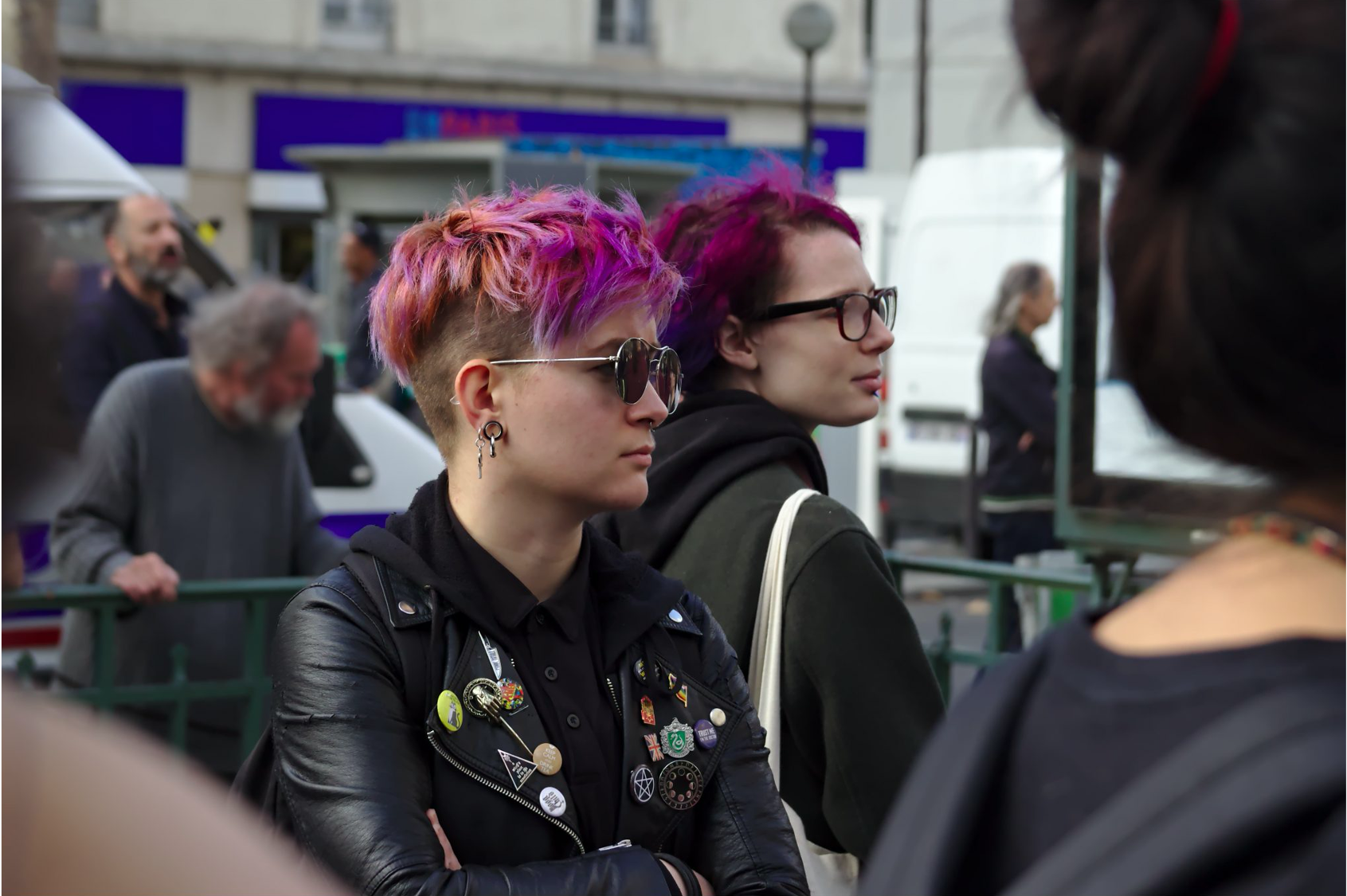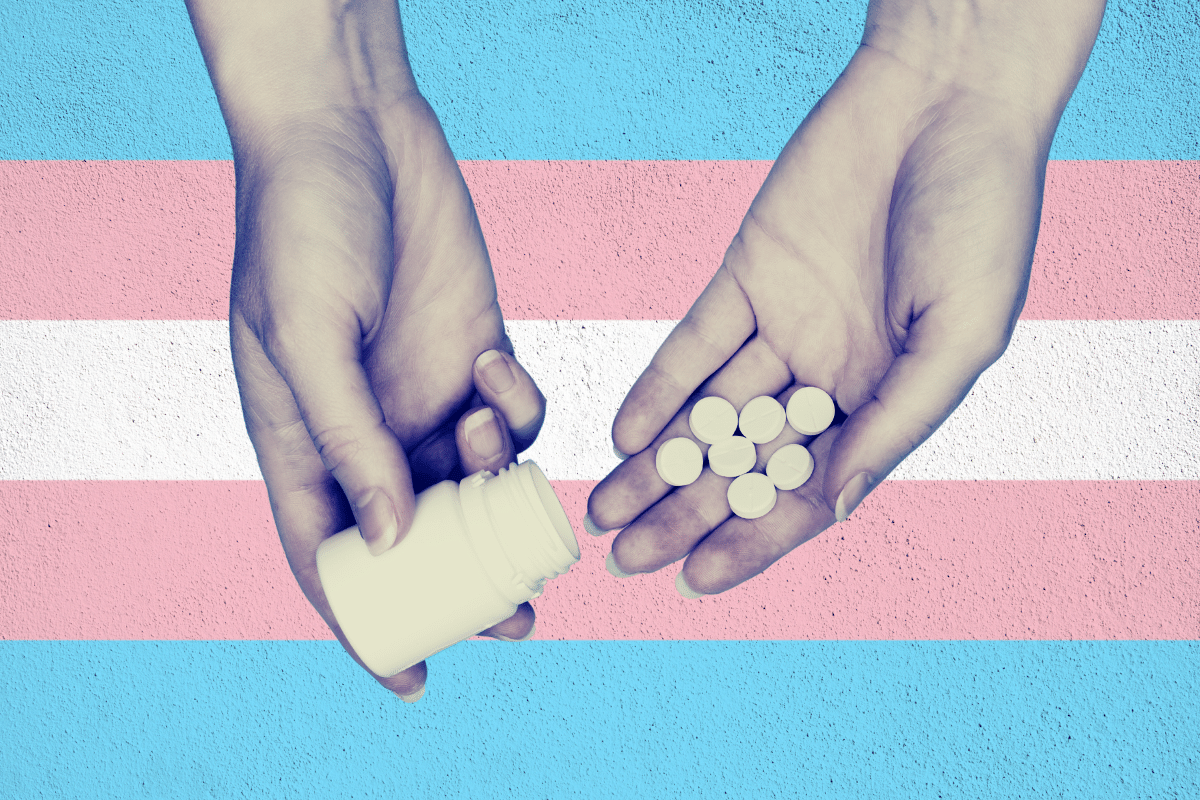Activism
When Sons Become Daughters, Part VI: Asexuality, Intelligence, and the Trans Co-Option of Intersex Discourse
Puberty had been distressing and rough. He’d began to cut himself, and saw transition as a way out.

What follows is the sixth instalment of When Sons Become Daughters, a seven-part Quillette series that explores how parents react when a son announces he wants to be a girl—and explains why so many of these mothers and fathers believe they can’t discuss their fears and concerns with their own children, therapists, doctors, friends, and relatives. To find out more about how the author collected and reported information, please refer to his introductory essay in this series.
Whether they exhibit autism spectrum disorder, obsessive-compulsive disorder, or attention deficit hyperactivity disorder, many trans-identified boys seem to be fixated on a hypothetical future self: Once brought to life, it is believed, this woman’s mere presence will resolve whatever existential crisis the young man is going through. In many cases, the boy will spend a lot of his time thinking about the differences between his status quo and his imagined (feminine) ideal. This “hyper-ruminative” behaviour is something many parents I interviewed discussed with me.
From Milwaukee, Liz emails me a number of papers she’s found over the years that describe correlations between high intelligence and sexual immaturity. As with many of the mothers I’ve met, her mind is an encyclopedia of information about transgenderism. Her own son, Leo, wears a set of girl’s clothes provided by a lesbian friend—but only when he sleeps. This made Liz suspect that her son might be part of that subclass of trans-identified males who exhibit what sexologist Ray Blanchard famously described as autogynephilia—“the tendency of certain males to become sexually aroused by the thought or image of themselves as females.” Some men with gender dysphoria are open about their autogynephilia. In other cases, it’s suggested by their behaviour. Many trans activists dismiss the concept altogether, arguing that it dehumanizes them by reducing their identity to a fetish.
Liz is liberal and open minded, and not one to vilify others on their sexual tastes. But in Leo’s case, the autogynephilia explanation doesn’t ring true to her, because she doesn’t believe her son has ever had an orgasm, much less masturbated in these clothes. “Would he admit it?” I ask. After all, there’s the old joke that 99 percent of young men masturbate, and 1 percent lie. She concedes that she has no way of knowing for sure. But her instincts are in line with many of the other parents I’ve spoken to, who also report that their sons are obsessed with gender while appearing to be indifferent to, or even fearful of, any kind of sexual activity.
For a brief period in middle school, Leo seemed like something of a Romeo. But then, at age 13, Leo announced he was asexual—which didn’t really faze Liz, who’d been a late sexual bloomer herself. After he announced that he was trans some time later, Liz and her husband gently began to probe him about his sexuality. “What do you do in the mornings, when you wake up with an erection?” they asked. Leo said he waited for it to go away.
As many readers are no doubt now doing, I cringed at Liz’s recollection of this highly awkward conversation. Liz cringes, too. But conversations such as this helped convince her that her son is, as he claims, an effectively asexual being.
Liz also asked Leo if he’d ever borrowed any of her clothes without telling her. At this, Leo looked horrified. “That would be stealing,” he said. In the end, Liz’s husband took an extraordinary step, and showed his son some soft porn—which can only have been an even more cringe-inducing experience. “Oh, so that’s what a vagina looks like,” said Leo. If he were an autogynephilic fetishist, surely the gig would have been up at this point.
Leo’s IQ has been measured at 157, which, while being extraordinarily high, isn’t even one of the highest that’s been reported in the Zoom parents’ group whose members I’ve been interviewing. Liz is certain that there’s a connection. Even putting aside the gender issue, “most of us know smart people who just aren’t that sexual,” she says. She points me to an article which details how men with very high—and very low—intelligence often don’t have sex until substantially later than their peers. This pattern apparently extends to masturbation, too. She teaches me a little about Kazimierz Dąbrowski’s Theory of Positive Disintegration, which rests on the notion of over-excitability: Bright people have not only more cerebral activity going on, but also more susceptibility to changes in their surroundings. The research materials that Liz shows me straddle neurology, intelligence measurement, and sexology; and the further she delves, the more connections she sees. Getting therapists to recognize these connections, on the other hand, is another matter—even though the links between autism spectrum disorders and transgenderism are, by now, well established.
I ask Liz why she thinks Leo likes wearing female clothing when he sleeps. Her theory is that the items of clothing are like stuffed toys, which help Leo cling to (a pre-sexual) childhood. She points out that the anime girl characters that are so popular among trans-identifying male teenagers typically seem to be having fun, bouncing around an infantilized fantasy world. None of that is to say that Leo won’t eventually become a sexual person, whether straight, gay, autogynephilic, or otherwise. But for now, Liz simply wants her son to stop putting so much mental effort into defining himself, and to start simply being himself.
Topics such as sexual immaturity, pornography, masturbation, and autogynephilia feel like the hardest to broach when I’m talking with parents. But the discomfort seems to be primarily on my end. The mothers and fathers I’m speaking with tend to be educated people who are relaxed about sex. Not one of them has reacted with defensiveness when I ask about these delicate matters; most of them seem open to exploring all the possibilities, even those that might lead to their sons being labelled as fetishists.
* * *
Another American parent I spoke with, this one in the north-east coastal state of Maine, has a similar story of a sexually immature trans-identified son. But Brian’s son Nathan seems more serious about cross-sex hormones, having surreptitiously gotten a friend to order them online. Brian found out, however, and threw them away before Nathan could begin taking them. But the episode got Nathan talking about his fear of developing into a man. “Maybe I’ll never really pass as a woman,” he confessed to his father, “but you can’t expect me to put up with feeling like this forever.” Whatever like this means for Nathan, the oestrogen pill has become an imagined ambrosia. Puberty had been distressing and rough. He’d began to cut himself, and saw transition as a way out.
Nathan dabbles with aspects of female appearance, wearing floaty camisoles and growing his hair long. Unlike Leo, he did steal clothes and makeup—from his sister’s room—although not regularly. But Brian, like Liz, is convinced that there is no sexual aspect to this behaviour, and that his son is totally asexual. Like other parents I’ve spoken to, Brian is aware of autogynephilia; how it manifests itself; how autogynephiles can seem threatening to women because of their insistence on entering single-sex spaces. Nonetheless, he doesn’t see his son as being part of this category. Many of the most aggressive male trans activists clearly seem to be impelled, at least in part, by their sexuality. But the gentle, self-effacing young man whom Brian describes is on the opposite end of the personality spectrum. Nathan is highly literate, well-versed in history, politics, and current events.
At points, Brian wondered if Nathan might just be gay; but while Nathan claims to be attracted to girls, there’s been no sign of any activity on either front. Like Liz, Brian talks openly with his son about sex, providing a non-judgmental space in which he can divulge any fetishes he might have. But, like Leo, Nathan seems to be put off by the idea of sex in general.

Nathan, Leo, and boys like them defy the traditional image of the male “cross-dresser” (as they were once called). Not only is there nothing here to indicate an aggressive paraphilia (or kink, to use the more colloquial term); there’s almost nothing to indicate any kind of sexuality. If anything, what they have in common is a form of sexual infantilization, a longing for a pre-sexual sense of self that plays out through a girly (as opposed to womanly) form of self-conception.
* * *
Claire—this is her real name, as distinct from the pseudonyms I am otherwise using—is an Englishwoman in her 40s. She was born with Mayer-Rokitansky-Küster-Hauser syndrome, or MRKH. This condition places her in the political category of “intersex,” comprising people born with sex characteristics that do not entirely fit the typical definitions for either male or female bodies. None of this was known to Claire until her first period was so late that she wondered whether it would ever come at all. It didn’t: One symptom of MRKH is that the uterus doesn’t develop, and so the woman doesn’t menstruate or have the capacity to bear children. The medical profession now has improved techniques for helping young women such as Claire; two and a half decades ago, she and her family were left to navigate the situation by themselves. But they found a way to move forward, and Claire got on with life.
Some years later, when Claire first heard a male-to-female trans activist argue that talking about uteruses is traumatic to those who identify as female but don’t have uteruses, she took issue. Uterus chat doesn’t cast her into a pit of despondency. Her three sisters (none of whom has MRKH) all have uteruses, and their candid discourse about female sexual health doesn’t bother Claire. The activists she spoke to were miffed by this: Surely, they argued, she of all people could understand how horrific it is to hear womanhood conflated with menstruation, childbirth, and the associated bodily paraphernalia. Maybe, they concluded, she ought to try thinking of herself as a man. On this point, too, Claire (looks like a woman; sounds like a woman; dresses like a woman; and is, in fact, a woman) was equally put off.
Claire is not alone: Within intersex circles, there are now some activists pushing back at what they see as the co-option of their medical conditions by trans activists who use the example of intersex conditions to support their contention that biology (and gender) aren’t “binary,” but rather exist on a continuum.
“Sex is binary,” Claire tells me plainly. “There are two gametes [eggs for women, sperm for men]. Classifying bodies is a bit more complicated, but we’re all ultimately female or male.” Nor does Claire believe she has any particular “gender identity.” Immediately after receiving her original intersex diagnosis, Claire tells me, she found herself questioning whether she really felt like a woman. It’s a question posed often to young, trans-identifying men by therapists and people they meet on social media. But this internal investigation never yielded an answer, and Claire decided it was moot anyway. She is a woman, MRKH or no, so it’s irrelevant how she feels about that fact.
One of the surreal aspects of her online debates, Claire tells me, is activists’ insistence on comparing her to creatures in the animal kingdom that can change sex, whose existence has become a popular talking point among those who insist that humans follow the same pattern. (The more formal term that describes this type of animal is sequential hermaphroditism.) These creatures include wrasses and moray eels. But the most popular example in the activist literature tends to be clownfish. In a given shoal, every resident clownfish is male, except for one female. When this female dies, the alpha male changes sex to become female. To discover her true (possibly “non-binary”) gender identity, Claire was instructed, all she needed to do was channel her inner clownfish.
Claire began to counter all this junk science by posting links to peer-reviewed papers that explained MRKH, as well as other differences of sexual development, in real scientific terms. Through her media appearances, she quickly gained a following, including among so-called “gender critical” feminists. “Does that make you an activist?” I ask her. “No,” she says, after a slight hesitation. “I’d rather call myself an advocate.”
Like me, Claire found herself involved in this debate by accident. And in the process, she’s made friends with trans people who feel quite angry about the way in which intersex people have been weaponized by gender theorists. This has included their co-option into the LGBTQIA acronym (despite the fact that intersex conditions comprise neither a sexuality nor a gender identity). But the average person—including the parents I’ve met—won’t know anyone with an intersex condition, and so probably won’t know how to respond to the associated claim that biological sex isn’t binary. (The proportion of the population that is intersex is estimated to be about 0.018 percent.)
As Claire’s following grew, so did the transphobia accusations from trans activists who resented her refusal to play her assigned role in the supposed LGBTQIA coalition. People started trying to find out where Claire lived, and began accusing her of all manner of unrelated thoughtcrimes, up to and including being a Nazi. One sock puppet account sent her pictures of dismembered animal genitalia for purposes that were never made clear. The lion’s share of these aggressive detractors were male, and most of them were young, Claire believes. And strangely, for reasons Claire can’t explain, many of them were “furries”—people who like dressing up in animal costumes (often for sex). “My medical condition has got nothing to do with your need to dress up as a sports mascot to achieve climax,” she posted. I’m not sure how anyone can argue against that.
In general, I am sympathetic to many of the young trans-identified men I’ve discussed in this series of articles, not just because I’ve heard their parents’ perspectives, but also because I don’t envy them for growing up in this social-media-saturated age. Yet I’m also aware that some of these same young individuals can behave viciously toward those, such as Claire, who are accused of being “transphobic” on the most spurious pretexts. And much of the worst abuse is meted out to women, such as J. K. Rowling, Abigail Shrier, Tulsi Gabbard, Kathleen Stock, Helen Staniland and Sarah Phillimore, to name only a few. None of these women has done anything that can reasonably be described as endangering anyone, yet the abuse they’ve received is of the sort one would normally associate with convicted pedophiles or actual Nazis. In Claire’s case, one self-described “supporter of the LGBTQIA community” said she had “a mutant cunt.” Astonishingly, the same people who use language such as this often imagine themselves to be great champions of social justice, and regularly argue that anyone demeaning their own bodies (or even pronouns) has committed a gravely hateful act.
Claire maintains her sense of sangfroid by reminding herself that her critics’ outsized hate and rage is a product of youthful self-absorption and performative hysteria. But she is genuinely concerned about the way that their toxic tactics can metastasize. On one occasion, Claire was trying to reason with a Facebook friend who’d drunk a little too much of the gender Kool-Aid, and was accusing her of transphobia. A radical feminist rode to the rescue, accusing Claire’s friend of being “the kind of guy who wears women’s knickers.” The conversation stopped. Claire had wanted to have a serious discussion about the implications of placing trans-identifying men in women’s prisons. What she got instead was a microcosm of the culture war. She was on the cusp of changing her friend’s mind: But the opportunity was lost.
Why did I include Claire’s story in a series of articles that otherwise focus on parents whose teenage boys long to be girls or women? Because the picture I’m presenting would be incomplete if I did not also profile the social-media environment in which these boys learn, and perform, their gender politics. I’m certain that any of the parents I’ve interviewed would be aghast if their sons were speaking to women such as Claire in this kind of way. And while it’s possible that one or two of the boys I’ve profiled have behaved in this way online, I doubt that all of them have. (As Claire points out, the most vicious rhetoric often comes from “trans allies,” rather than from trans-identifying young people themselves.) This behaviour is enabled by an Internet culture that allows us to cultivate different selves, each existing in discrete, compartmentalized worlds. Couple this with a schooling system obsessed by the hunt for transphobia, and it’s plausible that many otherwise kind and thoughtful young men would think that this kind of abusive behaviour, when directed at the right kind of target, is acceptable.
This darker aspect of trans activism is personal for Claire. Like many people, she’s found herself on the wrong end of moral absolutism: When it comes to gender dogma, you’re either a believer or you’re not. And in my next, and final, instalment in this series, I’ll discuss how this brittle dynamic has hindered the ability of everyone to engage in productive discussions about the best way to treat gender dysphoric youth.
With thanks to Liz, Brian, and Claire for taking the time to speak to me.
Angus Fox (a pseudonym) is an academic working in an unrelated field of study. He can be contacted at [email protected].
Featured image: Attendees at a 2017 LGBTI rights event






